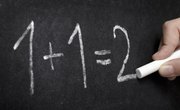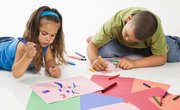Number stories are also called story problems -- perhaps in part because they illustrate how math is used to solve problems in real-world situations. Number stories are first introduced in first grade as a way to help students make sense of number relationships.
Act It Out
Get your students moving with some gross and fine-motor activities designed to help them create and understand number stories. Tell your students a number story and ask them to act it out as you tell it. For example, you might say: "Nathan held up one pencil and two pens. Amy held up two pencils and two pens. How many pencils and pens do Nathan and Amy have altogether?" As they act it out, write the number story on the board. If your students can read, try writing the story on the board and having them act it out as you write it. Use subtraction, multiplication and division as appropriate. Alternately, pass out manipulatives to your students and have them act out the number story with the manipulatives as you tell it. Write the story on the board. Finally, ask them use manipulatives to create and write their own stories. Younger children who cannot write well might be asked to recite stories as you type them or can work together to create a whole-class number story.
Read a Story
Almost any story that features counting or numbers can be used to create your own number stories in class. For example, read your students "The Three Little Pigs," and then ask them to write a number story based on the first few pages of the book. An example might be, "One pig was in a straw house. When the wolf blew the house down, the pig ran to his friend's house. Then there were two pigs in the stick house." Older children can write their own stories based on a few facts that you give them. Give the students some characters and numbers and ask them to create their own stories. For example, you might tell fourth-graders to use 50 zombies invading five movie theaters to write their own multiplication number stories.
Draw a Picture
Drawing a picture often helps inspire reluctant writers to start writing. This is especially true of young children, who might need to see how the numbers interact before they actually write about them. Ask the students to imagine they received some fish for Christmas, for example, then lead them with a few questions relating to what type and color of fish. Have them draw a picture of the fish in their aquarium and write a number story based on the picture. Older students might be challenged by first creating an elaborate collage or mosaic out of torn paper or ceramic tiles and then being told to create a number story based on the artwork by choosing its shapes or colors.
Use Real Data
Use real data from your classroom as a jumping-off point for creating number stories. When you take the lunch count, for example, ask the students to write a quick number story based on how many students want hot lunch and how many do not. Or compile the spelling test scores and ask the students to write a number story that tells how many more students got A's than B's on the test -- without using names, of course. In this way you can integrate math and writing throughout the day.











